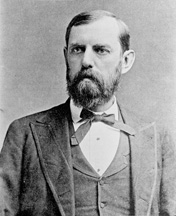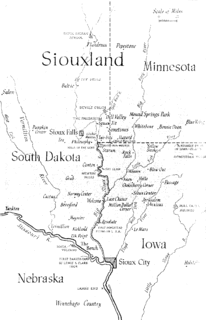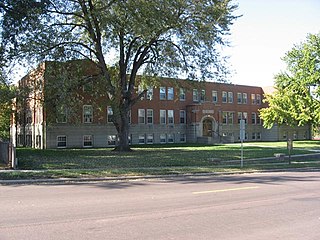
Yankton is a city in and the county seat of Yankton County, South Dakota, United States.

Sioux Falls is the most populous city in the U.S. state of South Dakota and the 131st-most populous city in the United States. It is the county seat of Minnehaha County and also extends into Lincoln County to the south, which continues up to the Iowa state line. As of 2020, Sioux Falls had a population of 192,517, which was estimated in 2022 to have increased to 202,600. The Sioux Falls metro area accounts for more than 30% of the state's population. Chartered in 1856 on the banks of the Big Sioux River, the city is situated in the rolling hills at the junction of interstates 29 and 90.

Richard Franklin Pettigrew was an American lawyer, surveyor, and land developer. He represented the Dakota Territory in the U.S. Congress and, after the Dakotas were admitted as States, he was the first U.S. Senator from South Dakota.

Siouxland is a vernacular region that encompasses the entire Big Sioux River drainage basin in the U.S. states of South Dakota, Minnesota, Nebraska and Iowa. The demonym for a resident of Siouxland is Siouxlander.

The National Museum of the United States Navy, or U.S. Navy Museum for short, is the flagship museum of the United States Navy and is located in the former Breech Mechanism Shop of the old Naval Gun Factory on the grounds of the Washington Navy Yard in Washington, D.C., United States.

Gideon Curtis Moody was an attorney and politician, elected in 1889 as a Republican United States Senator from South Dakota. He served two years. He also had served five years as an associate justice of the Dakota Territory Supreme Court, from 1878-1883, before entering private practice for a period as general counsel for Homestake Mine.
South Sioux Falls was an incorporated community located in south-central Minnehaha County, South Dakota, United States. It existed from 1890 until 1955. The community was centered in present-day Sioux Falls along Minnesota Avenue, stretching from 33rd Street in the north to 57th Street in the south.

The Sioux Quartzite is a Proterozoic quartzite that is found in the region around the intersection of Minnesota, South Dakota, and Iowa, and correlates with other rock units throughout the upper midwestern and southwestern United States. It was formed by braided river deposits, and its correlative units are thought to possibly define a large sedimentary wedge that once covered the passive margin on the then-southern side of the North American craton. In human history, it provided the catlinite, or pipestone, that was used by the Plains Indians to carve ceremonial pipes. With the arrival of Europeans, it was heavily quarried for building stone, and was used in many prominent structures in Sioux Falls, South Dakota and shipped to construction sites around the Midwest. Sioux Quartzite has been and continues to be quarried in Jasper, Minnesota at the Jasper Stone Company and Quarry, which itself was posted to the National Register of Historic Places on January 5, 1978. Jasper, Minnesota contains many turn-of-the-century quartzite buildings, including the school, churches and several other public and private structures, mostly abandoned.
The culture of the U.S. state of South Dakota exhibits influences from many different sources. American Indians, the cultures of the American West and Midwest, and the customs and traditions of many of the state's various immigrant groups have all contributed to South Dakota art, music, and literature.

The Federal Building and U.S. Courthouse, also known as U.S. Courthouse, Sioux Falls, is a historic federal office and courthouse building located at Sioux Falls in Minnehaha County, South Dakota. The building is still in use as a federal courthouse, being the seat of the United States District Court for the District of South Dakota. The structure is listed on the National Register of Historic Places.

The Great Plains Zoo and Delbridge Museum of Natural History is a 45-acre (18 ha) zoo and museum located in Sioux Falls, South Dakota, United States. The Delbridge Museum of Natural History displays 150 mounted animals, including 38 "vanishing species". The Great Plains Zoo is owned and operated through a partnership between the City of Sioux Falls and the Zoological Society. The City of Sioux Falls owns the infrastructure, land, and all assets associated with the Zoo and Museum and maintains the grounds. The Zoological Society of Sioux Falls, a non-profit, operates the facility, manages the animal collection, and maintains the grounds within the exhibit. The mid-sized Great Plains Zoo was awarded the "Quarter Century Award" by the Association of Zoos and Aquariums (AZA) in 2016, marking 25 years of continuous accreditation.

Wallace L. Dow (1844-1911), often known as W. L. Dow, was an architect of Sioux Falls, South Dakota. He has been referred to as the "Builder on the Prairie" and was "considered the premier architect of South Dakota in the late 19th century."
The following is a timeline of the history of the city of Sioux Falls, South Dakota, USA.

Calvary Cathedral is an Episcopal cathedral in Sioux Falls, South Dakota, United States. It is the seat of the Diocese of South Dakota.

The 1896 South Dakota gubernatorial election was held on November 3, 1896. Incumbent Republican Governor Charles H. Sheldon declined to run for re-election to a third term. Former Secretary of State Amund O. Ringsrud was nominated as Sheldon's replacement at the Republican convention. Ringrud's main opponent was businessman Andrew E. Lee, who was nominated by a makeshift coalition of Populists, Free Silver Republicans, and Democrats. In the general election, Lee narrowly defeated Ringsrud, the first defeat for the Republican Party in a gubernatorial election since statehood.

The Old Minnehaha County Courthouse, located at Main Avenue and 6th Street in Sioux Falls, is the former county courthouse of Minnehaha County, South Dakota.
Harold Theodore Spitznagel was an American architect from South Dakota. Spitznagel was best known for residential and institutional architecture, including the original Mount Rushmore visitor center. His styles included Prairie School, Art Deco, and Moderne architecture. He graduated from the University of Pennsylvania, was posthumously inducted into the South Dakota Hall of Fame, and has been called the "foremost 20th-century architect" of the state of South Dakota.

Belle L. Pettigrew was an American educator and missionary. She was a member of the Daughters of the American Revolution and the Anti-Saloon League. She served as head of the missionary and training department of the Woman's American Baptist Home Mission Society, and as South Dakota State superintendent of the press department for the Woman's Christian Temperance Union (W.C.T.U.). Hailing from Vermont, she traveled extensively around the world and lived in many cities in the United States before settling, like her brother Richard, a United States Senator, in Sioux Falls, South Dakota, where she died.

The Presentation Children's Home is a historic building at 701 South Western Avenue in Sioux Falls, South Dakota. Built to replace an earlier orphanage in Turton that burned down, it functioned not only as an orphanage—one of the few in South Dakota—but also as a school from its opening in 1940 to its closure in 1966. It was added to the National Register of Historic Places in 1993.

Cathedral Historic District, originally the Sioux Falls Historic District, is a 79-acre (32 ha) area located in Sioux Falls, South Dakota. Named for its centerpiece and key contributing property, the Cathedral of Saint Joseph, the district covers the neighbourhood historically known as Nob Hill, where multiple prominent pioneers, politicians, and businessmen settled in the late 19th and early 20th centuries. These homes primarily reflect Queen Anne and Mediterranean Revival architectural styles. In 1974, the neighborhood was listed as a historic district on the National Register of Historic Places (NRHP); at the time of this listing, there were 223 buildings, not all contributing, within the district's boundaries.



















